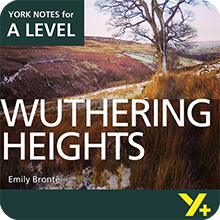Examiner's Notes
You assessed this answer as a Very High.
Hover over the highlighted text to read the examiner’s comments. These are linked to the Assessment Objectives, which are listed in the side panel.
Although ‘Wuthering Heights’ has been called the world’s greatest love story, it is nevertheless a novel fraught with clashing relationships. Indeed, with the possible exception of Nelly’s relationships with all the characters, there isn’t one that isn’t shot through with conflict. Conflict is at the heart of this novel, and Brontë appears to view it in different ways. For instance, the conflict between Heathcliff and Catherine represents the passion of their relationship yet the conflict between Isabella and Heathcliff merely indicates how totally ill-suited they are to each other. Much of the conflict in the novel can be put down to class divisions. Heathcliff comes into the family house from the outside, having been found on the streets in Liverpool: he belongs nowhere, is possibly illegitimate, has no property, not even his own name. Mr Earnshaw’s preference for this ‘poor fatherless child’ sows the seeds of conflict which will grow throughout the novel. Right from the beginning then we can see that there is a potential conflict with the arrival of an unwanted child.
This struggle reflects the social conditions of the time. The novel was written during the Industrial Revolution, a time of great social upheaval, when out of conflict came greatness, and new technologies. There were also lots of children left abandoned or orphaned on the streets because of enormous inner city poverty. A novel clearly enables the writer to develop conflict over time, laying its foundations and then building on them as the novel progresses. In poetry, establishing conflict has to be done much more economically, but it is interesting that the Metaphysical poet Andrew Marvell in his poem ‘To His Coy Mistress’ uses the concept of time to establish the idea of conflict ‘Had we but World enough, and Time, This coyness Lady were no crime.’ Marvell is at the mercy of time, not only as a lover, but also as a poet. The conflict he feels makes the need to express his love more urgent. The poem goes on to detail how much the poet desires his mistress, but because of social conventions about what is acceptable behaviour, and because time is not on their side, he feels in danger of losing her, as he says in despair: ‘And your quaint Honour turn to dust; and into ashes all my Lust.’ This last quotation also suggests that his love has boundaries, and cannot extend beyond death, which contrasts with the passion between Catherine and Heathcliff.
Anne Sexton’s poem ‘For My Lover, Returning to His Wife’ uses a series of metaphors and similes for establishing the conflict in the poet’s heart when she considers the wife, whom she describes as being like fireworks or a cooking pot. There is something brilliant about the wife, with which she cannot compete, and she is also undeniably real, solid and practical. Brontë also makes use of metaphor and simile for describing the conflicting passions which Catherine feels for her lover (Heathcliff) and her husband (Edgar) ‘The contrast resembled what you see in exchanging a bleak, hilly, coal country for a beautiful fertile valley.’ The use of nature imagery here suggests the different qualities of the two men: Heathcliff is bleak but solid, with hidden depths that may yet bring riches; Edgar is softer, aesthetically pleasing, and fertile. These suggestively contrasting descriptions developed as the novel progresses.
In ‘Wuthering Heights’, Brontë is able to develop a much more complex and contrasting account of the various conflicts between the characters. For instance, when Catherine is courting Edgar in Volume I, there is a clear conflict of wills between herself and Edgar. Edgar’s basic powerlessness is remarked upon by Nelly ‘he’s doomed, and flies to his fate’, but what sets the tone of the whole passage is the underlying violence that simmers throughout.
Anne Sexton hints at violence in only one stanza in her poem, but the sentiment is just as dark, and we are in no doubt as to the power of the poet’s feelings. The reference to the wife as a cooking pot puts her firmly in the kitchen, as the traditional idea of a woman’s place, but the word ‘fireworks’ makes it seem like the poet herself would like to occupy that place.
So, the conflict comes from a clash of personalities in Brontë’s case, but it is also a conflict that arises because of power and social class. Catherine chooses to marry Edgar because without him she is reduced to poverty. This highlights an issue that is also relevant in Sexton’s poem: the power of women. Catherine’s conflict comes because she does not have the power to make her own choice. Society has decided that in order for her to survive she has to marry someone who has property. Similarly in Sexton’s poem, the mistress has no power, no substance of her own – she washes off like watercolour paint.
